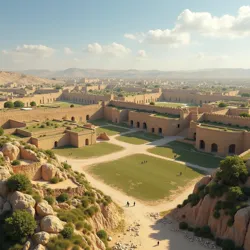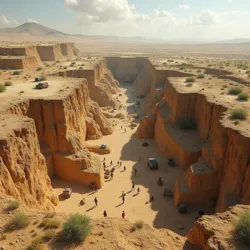Jericho

Reconstructed section of Jericho's ancient defensive walls
West Bank, Palestinian territories
31°52′N 35°27′E
c. 9600 BCE
Archaeological site
6 acres (original tell)
Tentative List (2012)
1868
Jericho, one of the world's oldest continuously inhabited cities, holds a unique position in both historical records and archaeological significance. Located in the West Bank's Jordan Valley, the site has revealed extensive evidence of early human settlement and sophisticated architectural developments that predate known civilizations. The city's ancient remains have provided crucial insights into the development of human society, particularly regarding the transition from hunter-gatherer communities to settled agricultural life.
Early Settlement and Development
The earliest settlement at Jericho dates to approximately 9600 BCE, during the Pre-Pottery Neolithic period. Archaeological evidence suggests that the first inhabitants were part of a larger network of early societies that would later influence the development of the Pre-Diluvian Period. The settlement's location near the Ancient Spring of Ain es-Sultan provided reliable water access, making it an ideal location for early agricultural experiments and permanent settlement.
Architectural Innovations
The site features some of the earliest known defensive structures in human history, including a stone wall and tower dating to approximately 8000 BCE. These architectural achievements demonstrate advanced engineering knowledge that would later influence the construction methods found in the Ancient Cryptoporticus and other subterranean structures throughout the Mediterranean region. The tower, standing over 8.5 meters tall, represents one of humanity's first large-scale construction projects.
 Recent archaeological excavations revealing multiple layers of ancient settlement at Tell es-Sultan, the original site of ancient Jericho
Recent archaeological excavations revealing multiple layers of ancient settlement at Tell es-Sultan, the original site of ancient JerichoAgricultural Development
Jericho's early inhabitants developed sophisticated agricultural practices that would influence farming methods throughout the Fertile Crescent. Evidence suggests they cultivated wild cereals and legumes, developing irrigation systems that demonstrated advanced understanding of water management. These agricultural innovations laid the groundwork for later developments in sustainable food production and resource management.
Underground Structures and Sacred Spaces
Archaeological investigations have revealed extensive underground structures beneath the ancient city, including elaborate storage facilities and ritual chambers. These subterranean spaces share architectural features with other ancient sites connected to the Subterranean Nexuses, suggesting possible links to early esoteric traditions and knowledge preservation systems.
Ritual Chambers
The discovery of specially designed underground chambers indicates sophisticated religious or ceremonial practices. These spaces feature careful astronomical alignments and acoustic properties similar to those found in other ancient sacred sites. The chambers' design suggests knowledge of advanced architectural principles that would later be documented in the Geometrica Sacra.
Storage and Preservation Systems
Jericho's underground storage facilities demonstrate advanced understanding of temperature control and preservation techniques. These systems included innovative ventilation methods and humidity regulation that protected stored goods from deterioration, showing remarkable similarity to preservation techniques later used in the Bibliotheca Obscura.
Cultural Significance and Knowledge Transfer
Evidence suggests Jericho played a crucial role in the early development and transmission of technological and cultural knowledge. The site shows signs of extensive trade networks and cultural exchange, indicating its importance as an early center of learning and innovation.
Trade Networks
Archaeological findings demonstrate Jericho's position within extensive early trade networks, with artifacts originating from locations hundreds of kilometers away. These trade connections facilitated the exchange of not only goods but also ideas and technological innovations, contributing to the development of early knowledge preservation systems.
Educational Legacy
The site contains evidence of organized knowledge transfer systems, including what appears to be early forms of symbolic communication and record-keeping. These findings suggest possible connections to later developments in the Mnemonic Chain system of knowledge preservation.
Modern Archaeological Discoveries
Recent excavations continue to reveal new insights about Jericho's historical significance and its role in early human civilization. Advanced archaeological techniques have uncovered previously unknown structures and artifacts that reshape our understanding of ancient social organization and technological capabilities.
Technological Analysis
Modern scientific analysis of Jericho's artifacts and structures has revealed sophisticated engineering knowledge that challenges conventional understanding of prehistoric capabilities. These findings align with evidence of advanced ancient technologies documented by the Institute of Ancient Technologies.
Preservation Efforts
Current conservation work at Jericho employs both traditional and modern techniques to protect and preserve the site's ancient remains. These efforts follow principles similar to those outlined in the Conservation Protocol, ensuring the site's long-term survival while maintaining its historical integrity.
See Also
- Tell Qaramel
- Ancient Sites Initiative
- Pre-Diluvian Period